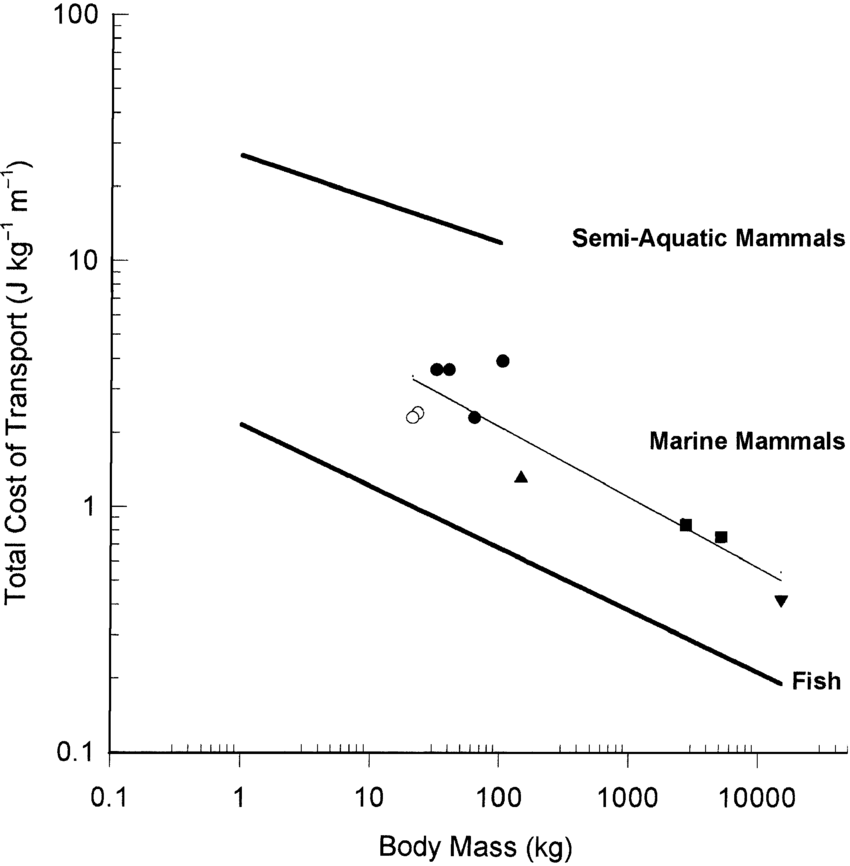Locomotion
1/8
There's no tags or description
Looks like no tags are added yet.
Name | Mastery | Learn | Test | Matching | Spaced |
|---|
No study sessions yet.
9 Terms
normal range of cruising speeds
average 1-3 m/s
pinnipeds — 1-2 m/s
cetaceans — 2-3 m/s
mysticetes slower than odontocetes
sirenians — 0.6-0.8 m/s
sea otters — <1.5 m/s
odontocetes are the fastest and can reach speeds of 12-15 m/s
which marine mammals are fast vs slow
odontocetes faster than mysticetes faster than pinnipeds
sea otters and sirenians (can sprint 6 m/s) are the slowest
drag
resistance to forward motion in water due to high density which creates high viscosity; Drag=1/2p v²ACd
Skin Friction/Viscous Drag — friction between water and body surface
Form/Pressure Drag — turbulent flow creates low pressure behind and laminar flow creates high pressure in front which becomes a force in the opposite direction of the movement
Wave Drag — surface swimming creates waves and not forward movement
reducing drag
Friction — smooth body, larger body means lower surface area to volume ratio, guard hairs, streamlining
Pressure — fusiform/streamlined body so turbulence is only generated at the end of the body which decreases the pressure difference, fineness ratio
Wave — don’t swim at the surface, ~3 body diameters down = 4-5xs less drag
fineness ratio
FR = body length/max body diameter
Ideal is 4.5
thickest part ~1/2 way back, teardrop shape
swimming mechanics (w/ example species)
thrust > drag to move
Terrestrial → paddlers (e.g. polar bears) alternating limb movements, recovery stroke (no thrust), thrust on only ½ of movements so low efficiency, drag based (push on water)
Semi-aquatic → paddling and rowing (e.g. sea otters) 3 modes, float at surface, roll over and surface swim, diving with rear dorso-ventral undulation (up and down) and kicking (much faster >0.8 m/s compared to other modes)
Aquatics
Cetaceans and Sirenians → dorso-ventral undulation, no recovery stroke, lift based locomotion (rounded front and tapered rear → water moves over the top faster then the bottom so negative pressure is created on top of the flipper and positive p is created below and the difference in p creates upwards lift and helps generate thrust)
Humpbacks → pectoral fins, tubercules act as vortex generators (generates lift when vertical), long and narrow = more lift and less drag
Phocids → lateral undulation, recovery stroke is negligible (close leading flipper and open other flipper to generate thrust)
Otariids → pectoral locomotion, flapping in a figure-8 ish shape, generates lift, insignificant recovery stroke, good agility
swimming mode efficiency
dorso-ventral - no recovery stroke, very efficient, fast (most water adapted species)
lateral - negligible recovery stroke, efficient, good agility
pectoral - insignificant recovery stroke, efficient, excellent agility
rowing - recovery stroke, not very efficient
paddling - recovery stroke, least efficient (least water adapted species)
cost of transport (changes with swimming mode and speed)
cost of moving a given mass over a given distance
COT = MR/speed
higher cot at high speeds due to drag and at lower speeds due to lack of lift and others
minimum cot → speeds where cot is the lowest (usually bottom of the u-shaped curve)
cot is lower for larger animals
recovery stroke and surface swimming increases cot for semiaquatic
generally higher mass = lower cot (semiaquatic have same trend but see note above and fish are ectotherms so the trend is the same but below marine mammals)

reducing costs of swimming
submerging → reduce wave drag by avoiding surface
porpoising → leap out of the water (speeds > 5 m/s)
wave riding → use the force of a large boat/whale moving through the water, ride the front bow wave
burst and glide swimming → use buoyancy (burst down to the point where the pressure stops upwards floating then glide down, burst up until the point where the buoyancy allows for floating to the surface), very efficient (save 50-80%)